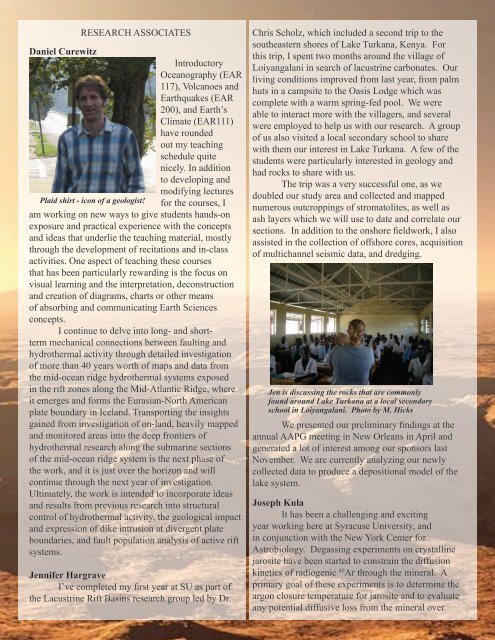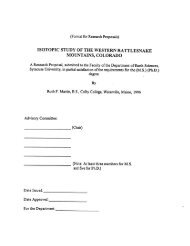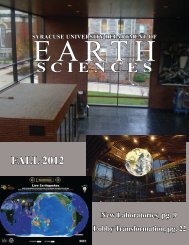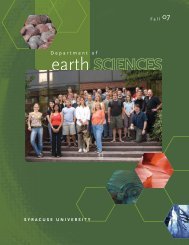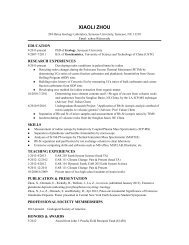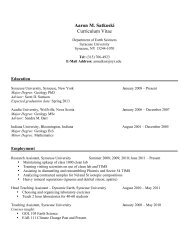alumni reception - Syracuse Universe Department of Earth Sciences ...
alumni reception - Syracuse Universe Department of Earth Sciences ...
alumni reception - Syracuse Universe Department of Earth Sciences ...
Create successful ePaper yourself
Turn your PDF publications into a flip-book with our unique Google optimized e-Paper software.
RESEARCH ASSOCIATES<br />
Daniel Curewitz<br />
Introductory<br />
Oceanography (EAR<br />
117), Volcanoes and<br />
<strong>Earth</strong>quakes (EAR<br />
200), and <strong>Earth</strong>’s<br />
Climate (EAR111)<br />
have rounded<br />
out my teaching<br />
schedule quite<br />
nicely. In addition<br />
to developing and<br />
modifying lectures<br />
Plaid shirt - icon <strong>of</strong> a geologist! for the courses, I<br />
am working on new ways to give students hands-on<br />
exposure and practical experience with the concepts<br />
and ideas that underlie the teaching material, mostly<br />
through the development <strong>of</strong> recitations and in-class<br />
activities. One aspect <strong>of</strong> teaching these courses<br />
that has been particularly rewarding is the focus on<br />
visual learning and the interpretation, deconstruction<br />
and creation <strong>of</strong> diagrams, charts or other means<br />
<strong>of</strong> absorbing and communicating <strong>Earth</strong> <strong>Sciences</strong><br />
concepts.<br />
I continue to delve into long- and shortterm<br />
mechanical connections between faulting and<br />
hydrothermal activity through detailed investigation<br />
<strong>of</strong> more than 40 years worth <strong>of</strong> maps and data from<br />
the mid-ocean ridge hydrothermal systems exposed<br />
in the rift zones along the Mid-Atlantic Ridge, where<br />
it emerges and forms the Eurasian-North American<br />
plate boundary in Iceland. Transporting the insights<br />
gained from investigation <strong>of</strong> on-land, heavily mapped<br />
and monitored areas into the deep frontiers <strong>of</strong><br />
hydrothermal research along the submarine sections<br />
<strong>of</strong> the mid-ocean ridge system is the next phase <strong>of</strong><br />
the work, and it is just over the horizon and will<br />
continue through the next year <strong>of</strong> investigation.<br />
Ultimately, the work is intended to incorporate ideas<br />
and results from previous research into structural<br />
control <strong>of</strong> hydrothermal activity, the geological impact<br />
and expression <strong>of</strong> dike intrusion at divergent plate<br />
boundaries, and fault population analysis <strong>of</strong> active rift<br />
systems.<br />
Jennifer Hargrave<br />
I’ve completed my first year at SU as part <strong>of</strong><br />
the Lacustrine Rift Basins research group led by Dr.<br />
Chris Scholz, which included a second trip to the<br />
southeastern shores <strong>of</strong> Lake Turkana, Kenya. For<br />
this trip, I spent two months around the village <strong>of</strong><br />
Loiyangalani in search <strong>of</strong> lacustrine carbonates. Our<br />
living conditions improved from last year, from palm<br />
huts in a campsite to the Oasis Lodge which was<br />
complete with a warm spring-fed pool. We were<br />
able to interact more with the villagers, and several<br />
were employed to help us with our research. A group<br />
<strong>of</strong> us also visited a local secondary school to share<br />
with them our interest in Lake Turkana. A few <strong>of</strong> the<br />
students were particularly interested in geology and<br />
had rocks to share with us.<br />
The trip was a very successful one, as we<br />
doubled our study area and collected and mapped<br />
numerous outcroppings <strong>of</strong> stromatolites, as well as<br />
ash layers which we will use to date and correlate our<br />
sections. In addition to the onshore fieldwork, I also<br />
assisted in the collection <strong>of</strong> <strong>of</strong>fshore cores, acquisition<br />
<strong>of</strong> multichannel seismic data, and dredging.<br />
Jen is discussing the rocks that are commonly<br />
found around Lake Turkana at a local secondary<br />
school in Loiyangalani. Photo by M. Hicks<br />
We presented our preliminary findings at the<br />
annual AAPG meeting in New Orleans in April and<br />
generated a lot <strong>of</strong> interest among our sponsors last<br />
November. We are currently analyzing our newly<br />
collected data to produce a depositional model <strong>of</strong> the<br />
lake system.<br />
Joseph Kula<br />
It has been a challenging and exciting<br />
year working here at <strong>Syracuse</strong> University, and<br />
in conjunction with the New York Center for<br />
Astrobiology. Degassing experiments on crystalline<br />
jarosite have been started to constrain the diffusion<br />
kinetics <strong>of</strong> radiogenic 40 Ar through the mineral. A<br />
primary goal <strong>of</strong> these experiments is to determine the<br />
argon closure temperature for jarosite and to evaluate<br />
any potential diffusive loss from the mineral over


